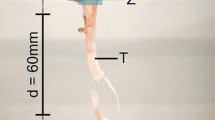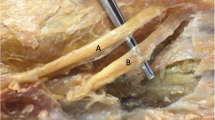Abstract
Introduction
Although a plenty of studies exist assessing the strength of ligamentous fixation techniques using porcine flexor digitorum profundus tendons as graft substitutes for human hamstring tendons, there is no biomechanical study comparing these two tendons. To interpret the results obtained with porcine flexor digitorum profundus tendons, knowledge of their biomechanical properties is essential. The purpose of this study was to compare the biomechanical properties of human hamstring tendons and porcine flexor digitorum profundus tendons.
Materials and methods
A total of six human hamstring tendons and six porcine flexor digitorum profundus tendons were analysed in this study. Quadruple-bundle human hamstring tendons and double-bundle porcine flexor digitorum profundus tendons with a diameter of 9 mm were used. Specimens were placed into a tensile loading fixation of a servohydraulic testing machine. Biomechanical analysis included pretensioning of the constructs at 50 N for 10 min following cyclic loading of 1500 cycles between 50 and 200 N at 0.5 Hz for measurement of elongation. Subsequently, ultimate failure load and failure mode analysis were performed with a ramp speed of 20 mm/min.
Results
Human hamstring tendons showed significantly higher maximum load to failure values compared to porcine flexor digitorum profundus tendons (1597 ± 179.6 N vs. 1109 ± 101.9 N; p = 0.035). Human hamstring tendons yielded significantly lower initial elongation during preload, but not during cyclical loading.
Conclusions
When porcine flexor digitorum profundus tendons are used as graft substitutes for human hamstring tendons in biomechanical studies, maximum load to failure is underestimated while elongation is comparable to that of human hamstring tendons. Transferring results of biomechanical studies into clinical practice, the lower maximum load to failure of porcine flexor digitorum profundus tendons needs to be taken into consideration.



Similar content being viewed by others
References
Adam F, Pape D, Schiel K, Steimer O, Kohn D, Rupp S (2004) Biomechanical properties of patellar and hamstring graft tibial fixation techniques in anterior cruciate ligament reconstruction: experimental study with roentgen stereometric analysis. Am J Sports Med 32:71–78
Becker R, Voigt D, Starke C, Heymann M, Wilson GA, Nebelung W (2001) Biomechanical properties of quadruple tendon and patellar tendon femoral fixation techniques. Knee Surg Sports Traumatol Arthrosc 9:337–342
Beynnon BD, Amis AA (1998) In vitro testing protocols for the cruciate ligaments and ligament reconstructions. Knee Surg Sports Traumatol Arthrosc 6(Suppl 1):S70–S76
Bollen S (2000) Epidemiology of knee injuries: diagnosis and triage. Br J Sports Med 34:227–228
Burnett QM, 2nd, Fowler PJ (1985) Reconstruction of the anterior cruciate ligament: historical overview. Orthop Clin North Am 16:143–157
Conner CS, Perez BA, Morris RP, Buckner JW, Buford WL Jr, Ivey FM (2010) Three femoral fixation devices for anterior cruciate ligament reconstruction: comparison of fixation on the lateral cortex vs. the anterior cortex. Arthroscopy 26:796–807
Feagin JA Jr, Lambert KL, Cunningham RR, Anderson LM, Riegel J, King PH, VanGenderen L (1987) Consideration of the anterior cruciate ligament injury in skiing. Clin Orthop Relat Res 216:13–18
Frank CB, Jackson DW (1997) The science of reconstruction of the anterior cruciate ligament. J Bone Joint Surg Am 79:1556–1576
Fu FH, Bennett CH, Lattermann C, Ma CB (1999) Current trends in anterior cruciate ligament reconstruction. Part 1: biology and biomechanics of reconstruction. Am J Sports Med 27:821–830
Griffin LY, Albohm MJ, Arendt EA, Bahr R, Beynnon BD, Demaio M, Dick RW, Engebretsen L, Garrett WE Jr, Hannafin JA, Hewett TE, Huston LJ, Ireland ML, Johnson RJ, Lephart S, Mandelbaum BR, Mann BJ, Marks PH, Marshall SW, Myklebust G, Noyes FR, Powers C, Shields C Jr, Shultz SJ, Silvers H, Slauterbeck J, Taylor DC, Teitz CC, Wojtys EM, Yu B (2006) Understanding and preventing noncontact anterior cruciate ligament injuries: a review of the Hunt Valley II meeting, January 2005. Am J Sports Med 34:1512–1532
Griffin LY, Agel J, Albohm MJ, Arendt EA, Dick RW, Garrett WE, Garrick JG, Hewett TE, Huston L, Ireland ML, Johnson RJ, Kibler WB, Lephart S, Lewis JL, Lindenfeld TN, Mandelbaum BR, Marchak P, Teitz CC, Wojtys EM (2000) Noncontact anterior cruciate ligament injuries: risk factors and prevention strategies. J Am Acad Orthop Surg 8:141–150
Hamner DL, Brown CH Jr, Steiner ME, Hecker AT, Hayes WC (1999) Hamstring tendon grafts for reconstruction of the anterior cruciate ligament: biomechanical evaluation of the use of multiple strands and tensioning techniques. J Bone Joint Surg Am 81:549–557
Herrera A, Martinez F, Iglesias D, Cegonino J, Ibarz E, Gracia L (2010) Fixation strength of biocomposite wedge interference screw in ACL reconstruction: effect of screw length and tunnel/screw ratio. A controlled laboratory study. BMC Musculoskelet Disord 11:139-2474-11-139
Higano M, Tachibana Y, Sakaguchi K, Goto T, Oda H (2013) Effects of tunnel dilation and interference screw position on the biomechanical properties of tendon graft fixation for anterior cruciate ligament reconstruction. Arthroscopy 29:1804–1810
Kitamura N, Yasuda K, Tohyama H, Yamanaka M, Tanabe Y (2005) Primary stability of three posterior cruciate ligament reconstruction procedures: a biomechanical in vitro study. Arthroscopy 21:970–978
Lee CH, Huang GS, Chao KH, Wu SS, Chen Q (2005) Differential pretensions of a flexor tendon graft for anterior cruciate ligament reconstruction: a biomechanical comparison in a porcine knee model. Arthroscopy 21:540–546
Lee JJ, Otarodifard K, Jun BJ, McGarry MH, Hatch GF 3rd, Lee TQ (2011) Is supplementary fixation necessary in anterior cruciate ligament reconstructions? Am J Sports Med 39:360–365
Lenschow S, Schliemann B, Schulze M, Raschke M, Kosters C (2014) Comparison of outside-in and inside-out technique for tibial fixation of a soft-tissue graft in ACL reconstruction using the Shim technique. Arch Orthop Trauma Surg 134:1293–1299
Lenschow S, Schliemann B, Gestring J, Herbort M, Schulze M, Kosters C (2013) Medial patellofemoral ligament reconstruction: fixation strength of 5 different techniques for graft fixation at the patella. Arthroscopy 29:766–773
Lenschow S, Herbort M, Strasser A, Strobel M, Raschke M, Petersen W, Zantop T (2011) Structural properties of a new device for graft fixation in cruciate ligament reconstruction: the shim technique. Arch Orthop Trauma Surg 131:1067–1072
Lenschow S, Schliemann B, Dressler K, Zampogna B, Vasta S, Raschke M, Zantop T (2011) Structural properties of a new fixation strategy in double bundle ACL reconstruction: the MiniShim. Arch Orthop Trauma Surg 131:1159–1165
Lipscomb AB, Johnston RK, Snyder RB, Warburton MJ, Gilbert PP (1982) Evaluation of hamstring strength following use of semitendinosus and gracilis tendons to reconstruct the anterior cruciate ligament. Am J Sports Med 10:340–342
Miyata K, Yasuda K, Kondo E, Nakano H, Kimura S, Hara N (2000) Biomechanical comparisons of anterior cruciate ligament: reconstruction procedures with flexor tendon graft. J Orthop Sci 5:585–592
Miyatake S, Kondo E, Tohyama H, Kitamura N, Yasuda K (2010) Biomechanical evaluation of a novel application of a fixation device for bone-tendon-bone graft (EndoButton CL BTB) to soft-tissue grafts in anatomic double-bundle anterior cruciate ligament reconstruction. Arthroscopy 26:1226–1232
Morris MW, Williams JL, Thake AJ, Lang Y, Brown JN (2004) Optimal screw diameter for interference fixation in a bone tunnel: a porcine model. Knee Surg Sports Traumatol Arthrosc 12:486–489
Niedzwietzki P, Zantop T, Weimann A, Herbort M, Raschke MJ, Petersen W (2007) Femoral fixation of hamstring grafts in posterior cruciate ligament reconstruction: biomechanical evaluation of different fixation techniques: is there an acute angle effect? Am J Sports Med 35:780–786
Ninomiya T, Tachibana Y, Miyajima T, Yamazaki K, Oda H (2011) Fixation strength of the interference screw in the femoral tunnel: the effect of screw divergence on the coronal plane. Knee 18:83–87
Nurmi JT, Sievanen H, Kannus P, Jarvinen M, Jarvinen TL (2004) Porcine tibia is a poor substitute for human cadaver tibia for evaluating interference screw fixation. Am J Sports Med 32:765–771
Omar M, Petri M, Dratzidis A, El Nehmer S, Hurschler C, Krettek C, Jagodzinski M, Ettinger M (2014) Biomechanical comparison of fixation techniques for medial collateral ligament anatomical augmented repair. Knee Surg Sports Traumatol Arthrosc
Prado M, Martin-Castilla B, Espejo-Reina A, Serrano-Fernandez JM, Perez-Blanca A, Ezquerro F (2013) Close-looped graft suturing improves mechanical properties of interference screw fixation in ACL reconstruction. Knee Surg Sports Traumatol Arthrosc 21:476–484
Prodromos CC, Fu FH, Howell SM, Johnson DH, Lawhorn K (2008) Controversies in soft-tissue anterior cruciate ligament reconstruction: grafts, bundles, tunnels, fixation, and harvest. J Am Acad Orthop Surg 16:376–384
Rylander L, Brunelli J, Taylor M, Baldini T, Ellis B, Hawkins M, McCarty E (2014) A biomechanical comparison of anterior cruciate ligament suspensory fixation devices in a porcine cadaver model. Clin Biomechc (Bristol, Avon) 29:230–234
Sakaguchi K, Tachibana Y, Oda H (2012) Biomechanical properties of porcine flexor tendon fixation with varying throws and stitch methods. Am J Sports Med 40:1641–1645
Sawyer GA, Anderson BC, Paller D, Heard WM, Fadale PD (2013) Effect of interference screw fixation on ACL graft tensile strength. J Knee Surg 26:155–159
Seo YJ, Yoo YS, Kim YS, Jang SW, Song SY, Hyun YS, Smolinski P, Fu FH (2014) The effect of notchplasty on tunnel widening in anterior cruciate ligament reconstruction. Arthroscopy 30:739–746
Shen HC, Chang JH, Lee CH, Shen PH, Yeh TT, Wu CC, Kuo CL (2010) Biomechanical comparison of cross-pin and Endobutton-CL femoral fixation of a flexor tendon graft for anterior cruciate ligament reconstruction—a porcine femur-graft-tibia complex study. J Surg Res 161:282–287
Shen PH, Lien SB, Shen HC, Wang CC, Huang GS, Chao KH, Lee CH, Lin LC (2009) Comparison of different sizes of bioabsorbable interference screws for anterior cruciate ligament reconstruction using bioabsorbable bead augmentation in a porcine model. Arthroscopy 25:1101–1107
Wu JL, Yeh TT, Shen HC, Cheng CK, Lee CH (2009) Mechanical comparison of biodegradable femoral fixation devices for hamstring tendon graft—a biomechanical study in a porcine model. Clin Biomech Bristol Avon 24:435–440
Yamanaka M, Yasuda K, Tohyama H, Nakano H, Wada T (1999) The effect of cyclic displacement on the biomechanical characteristics of anterior cruciate ligament reconstructions. Am J Sports Med 27:772–777
Zhang AL, Lewicky YM, Oka R, Mahar A, Pedowitz R (2007) Biomechanical analysis of femoral tunnel pull-out angles for anterior cruciate ligament reconstruction with bioabsorbable and metal interference screws. Am J Sports Med 35:637–642
Author information
Authors and Affiliations
Corresponding author
Ethics declarations
Dislcosure
All authors disclose any financial and personal relationships with other people or organisations that could inappropriately influence their work.
Conflict of interest
None.
Rights and permissions
About this article
Cite this article
Omar, M., Dratzidis, A., Klintschar, M. et al. Are porcine flexor digitorum profundus tendons suitable graft substitutes for human hamstring tendons in biomechanical in vitro-studies?. Arch Orthop Trauma Surg 136, 681–686 (2016). https://doi.org/10.1007/s00402-016-2425-9
Received:
Published:
Issue Date:
DOI: https://doi.org/10.1007/s00402-016-2425-9




